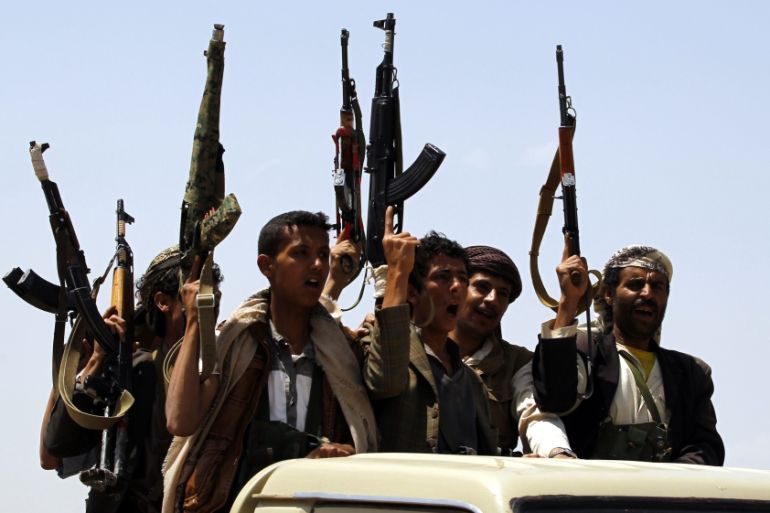Fearing landmines, displaced Yemenis wary of return
The Houthi rebels have been accused of planting landmines in Aden as they retreated, leading to more than 100 deaths.

Sanaa – Last month, Yemen’s Houthi rebels were pushed out of Aden, the country’s second-largest city.
But although the fighting there has stopped, some displaced residents remain reluctant to return. This includes Abdu Farea Aldhahri, 45, who fled Aden in March with his family of six to Sanaa, Yemen’s capital, after violence erupted.
Aldhahri decided to delay his return upon hearing that his neighbour had been killed by a landmine laid at the entrance to their neighbourhood. He said he spoke by telephone with the neighbour’s 14-year-old son, who strongly advised him not to return until the government took action on the mines.
“I was shocked when I heard what happened to my neighbour, and I thought of my children,” Aldhahri told Al Jazeera. “What if they had become victims of landmines?”
RELATED: Yemeni anti-rebel forces recapture Aden airport
The Houthis took over Sanaa last September, before advancing south towards Aden. Since March, thousands of people from Aden and neighbouring governorates have become refugees or internally displaced people (IDPs), as fighting has raged between the Houthis and supporters of ousted Yemeni President Ali Abdullah Saleh on one side, and on the other, armed groups known as the Popular Resistance, backed by air strikes launched by a Saudi-led coalition.
The Houthis have been accused of planting landmines in the governorates of Aden, Abyan and Lahj after their fighters retreated from the areas.
|
|
Al-Khathir Lasoar, the head of the government’s health office in Aden, told Al Jazeera that more than 100 people were reported to have been killed by landmines so far and more than 330 others injured – most of them in Aden. Mines have been laid by the Houthis on the roads leading to Aden from Abyan to the east, Taiz to the west, and Lahj to the north, he said.
Safwan Mahmoud, 26, who narrowly survived a landmine blast in the al-Basateen neighbourhood, but lost his younger brother, said he was standing a few metres away when the explosion occurred.
“I do not exactly remember what happened because I passed out seconds after I heard the blast, but afterwards, I found myself at the hospital with minor injuries to my head, and with the great loss of my brother,” Mahmoud told Al Jazeera. “I go through bouts of depression when I remember that.”
Lasoar said the Houthis have been “planting landmines in the areas adjacent to brigades, and in battlefields and in most residential neighbourhoods in Aden in retaliation for their defeat”. The Saudi-led coalition fighting against the Houthis has brought in an anti-mine team from Saudi Arabia and the United Arab Emirates, and they have been clearing mine-infested land in Aden, he added, noting the anti-mine team’s mission would also focus on the Abyan and Lahj governorates.
Adel Saeed, an expert at the Yemen Executive Mine Action Center (YEMAC), said that tens of thousands of mines, explosive devices and explosive remnants of war were left by the Houthis in southern Yemen. Most of the victims have been refugees and IDPs who recently returned to Aden, he said.
I saw 10 people killed and five others injured by landmines planted beside their homes... when they came back after the Houthis left the city.
Nevertheless, there has been substantial progress in removing the mines. According to Saeed, more than 4,000 landmines, explosive devices and explosive remnants of war around Aden’s airport and the Khawr Maksar district have been defused and removed. “The Houthis also laid 1,600 mines in the residential areas located in the vicinity of the Badr Brigade in Khawr Maksar, and they are a mix of anti-vehicle and anti-individual mines,” he added.
RELATED: Analysis: What now for Yemen?
For their part, the Houthis have admitted that they laid mines, but not in the way that the Popular Resistance has alleged. Mohammed al-Bukhaiti, a member of the Houthis’ political office in Sanaa, told Al Jazeera that the group planted mines only in battlefields and nearby areas.
“What else has been said are merely lies,” al-Bukhaiti said, denying that mines were planted in civilian areas.
Thia Hassan, head of the Aden-based NGO Thia Foundation for Rights and Development, said the group has been handing out brochures to raise awareness about the dangers of mines.
“We also called on other refugees and displaced people who are expected to return home not to take this action until the concerned bodies in the city survey the suspected areas and clear them [of mines],” Hassan told Al Jazeera.
“I saw 10 people killed and five others injured by landmines planted beside their homes in the al-Basateen area, north of Aden, when they came back after the Houthis left the city to determine whether or not their homes remained intact.”